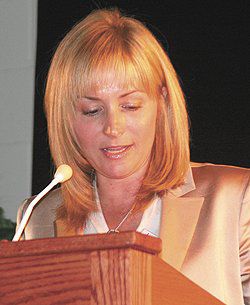The Southeastern Utah Energy Producers held their annual banquet on Oct. 2 at the Carbon County events center. SEUEPA’s president Rick Olsen welcomed everyone to the banquet. He is proud of SEUEPA’s growth and the organization has strength in numbers.
Deb Dull from Rocky Mountain Power introduced Dr. Laura Nelson from Ecoshale, a company involved with the development of oil shale. Nelson said energy is a critical and vital part of the lives we lead. Most people don’t think much about what is behind the production of energy. They just switch on their lights and take energy production for granted.
Ecoshale is operating in the Uintah Basin and can deliver the resource in a short amount of time. Why do we have to develop oil shale, Nelson asked. It can be a viable part of our energy future. The United States imports 58 percent of its energy needs. “Energy costs affect everyone. We need to work to offset our imports and give households greater support. Imports are expected to climb to 70 percent in the next few years,” said Nelson.
Nelson doesn’t view dependency on oil and energy as a bad thing. It has enabled our country to develop a good quality of life for its citizens. But with that dependency comes a responsibility to develop new energy sources. A lot of our petroleum is coming from the tar sands in Canada.
A percentage comes from Saudi Arabia and 20 percent comes from Africa. These sources from unstable parts of the world are cause for concern. Nelson said the last tests of reserves in the Middle East were in 1982. “We are counting on those reserves to be there, but we really don’t know. What can we do to off set our needs. We can look at efficiency. We are not super efficient, only 58 percent. Other countries are increasing their energy demands rapidly,” said Nelson.
Nelson said the country needs to look at unconventional energy sources. They have to be part of our future. Oil production in Mexico is declining. Nelson said renewables are only part of the answer, they are a small source. Renewables can’t meet the demand for the future. “Emerging countries seek a greater quality of life. We want to provide the same opportunities we have had to future generations. Unconventional energy is part of that future. We need it all, wind, solar, coal, biofuels, oil shale,” said Nelson.
Ecoshale holds leases on state and school trustlands, but no federal leases. Federal leases will be needed in the future to pursue oil shale more seriously. It’s estimated in Utah, Colorado and Wyoming there are 800 billion barrels of oil shale.
The technology to develop this oil shale is already in place. Nelson outlined the steps involved: Step 1: We carefully set aside overburden to preserve topsoil biodiversity. This allows us to rapidly reclaim the site within a few weeks, as well as support new grasses and brush for wildlife, within months.
Step 2: We build an environmental protection layer within an impoundment. Such clay impoundments are used to protect the environment in the mining industry and provide long-term protection of ground water and aquifers.
Step 3: We fill the impoundment with freshly mined ore from shale. The shale contains rich hydrogen content. The ore will be sized, sorted and roasted in the impoundment to extract a premium, bottomless fuel source.
Step 4: We place pipes that are designed to biodegrade harmlessly within the impoundment. Without using any water, we transfer dry, low emission heat from clean burning natural gas burners into the pipes. When finished, we remove the heat by circulating air through the pipes into the adjacent prepared impoundment. No rock is burned at any time. Instead, by burning clean natural gas, we avoid nearly two-thirds of typical retort emissions.
Step 5: Once we’ve completed heating the shale and producing 34 API gravity kerogen oil, we upgrade the kerogen to remove all nitrogen and sulfur. Upgraded kerogen oil is the feedstock for premium low sulfur diesel fuel–approved and highly sought-after by environmentally conscious energy consuming states such as California. ULSD is a premium fuel because it far outpaces the mileage efficiency of fuels such as ethanol, and can help Low Emission Diesel vehicles compete toe-to-toe with hybrids. In some cases, Low Emission Diesel vehicles (“green” diesel) achieve better mileage than hybrids.
Step 6. Our process mining is rapidly reclaimed. Instead of years to reclaim, we return native soils within weeks. New grasses and brush begin to appear within months.
Nelson said they are starting small with a five acre site which can produce 5,000 barrels a day. They have people ready to buy their product once it is produced.
“Yes it can be done and yes it can be done economically,” said Nelson. Ecoshale will use the best practices and technology available. They plan to be part of the communities where they work and will support and interact with the communities. Royalties from the product will go into the school trustlands funds and if federal leases are developed royalties will be generated that will be returned to the state of Utah. Nelson said oil shale has a 90 percent recovery rate.
Energy producers learn about oil shale

"Dr. Laura Nelson discusses oil shale production."
